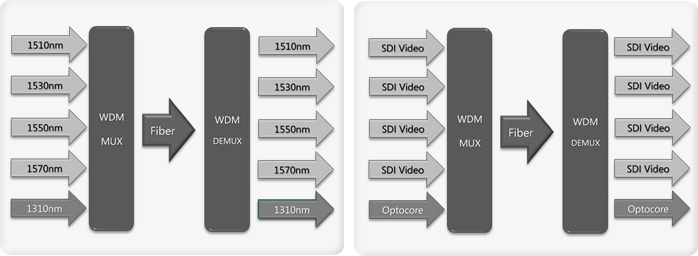Multiple signal channels are aggregated over a single fiber optic link using Wave Division Multiplexing – WDM.
Different wavelengths (colours) are combined/multiplexed and de-combined/de-multiplexed, using a passive prism and filters.
WDM is an alternative to TDM multiplexing where the signals are sent in a serial transmission (original multiplexing method of the digital telco). TDM requires the signals to be synchronous (clocking rules are very strict and get stricter as the data rate gets higher) and has practical limits on the size of the data pipe. WDM technology allows for different signals, at different data rates, in different clock domains to be tunnelled together.
Going forward, WDM is better suited and more capable of expanding, with increase in required signal bandwidth for professional video signals, than TDM based systems.
Each SDI video channel in BroaMan systems is represented by its own unique wavelength.
BroaMan products allow multiplexing of any 3rd party fiber channels (SMPTE cameras, audio protocols, 1Gbit Ethernet tunnel) when the wavelength is specified by the customer. Single BroaMan channels can be reserved for a full 2GBit Optocore stream offering a transport of up to 1024 audio channels, Ethernet, serial data and sync.
BroaMan systems offer WDM, CWDM or DWDM multiplexing technology with up to 240Gbit bandwidth on a single fiber strand:
- Up to 2 SD/HD/3G-SDI video channels per fiber link using WDM
- Up to 8 (or 181) SD/HD/3G-SDI video channels per fiber link using CWDM
- Up to 80 SD/HD/3G-SDI video channels per fiber link using DWDM
1 Systems with channel count above 8 using CWDM require the water-peak free fiber cable.
Devices offering Multiplexing:
Repeat48 WDM, Mux22, Route66, WDM Frame

